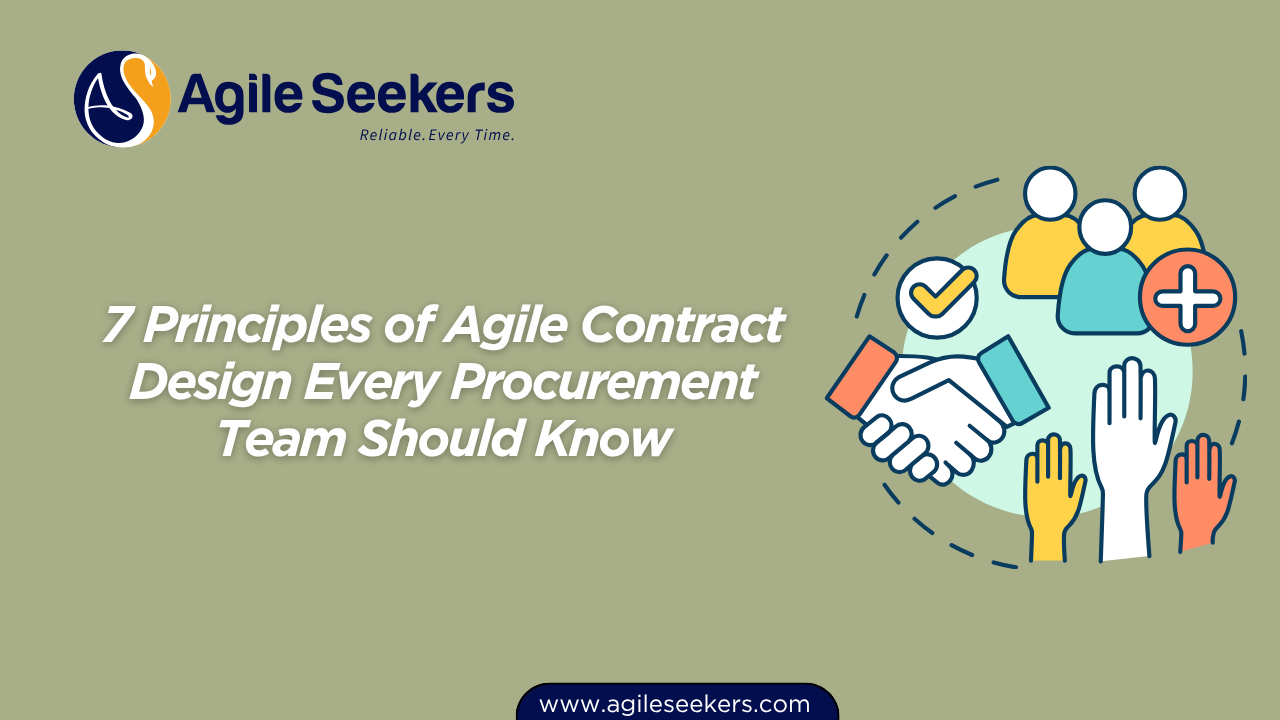7 Principles of Agile Contract Design Every Procurement Team Should Know

Agile contract design isn’t just a legal exercise—it’s a key enabler of collaboration, flexibility, and continuous value delivery. Traditional procurement models that focus on fixed scope, timelines, and cost structures often clash with the iterative and adaptive nature of Agile. That’s why procurement teams need a new playbook—one that aligns with Lean-Agile principles.
Below are seven core principles of Agile contract design every procurement team should understand and apply:
1. Focus on Outcomes, Not Outputs
Traditional contracts emphasize deliverables and timelines. Agile contracts, in contrast, shift the focus to business outcomes. Rather than specifying what to build, contracts should clarify why it's being built and what value it will deliver.
This shift supports value-driven decision-making, which is a cornerstone of the SAFe Product Owner/Product Manager (POPM) certification. POPMs are trained to prioritize customer-centric outcomes over checklist-based outputs, a mindset procurement must share to enable Agile teams.
✅ Instead of: “Vendor shall deliver Module A by Date X”
✅ Use: “Vendor shall improve system availability by 30% within 3 months”
2. Enable Incremental Delivery and Acceptance
Agile contracts should support short iterations, with working increments delivered and accepted regularly. This principle de-risks large projects by creating visibility into progress and quality throughout the lifecycle.
Procurement can structure payments based on validated increments instead of milestones that depend on documentation alone. This aligns perfectly with Agile team cadences taught in SAFe Scrum Master certification training, where teams commit to delivering value every iteration.
🔄 Iterative delivery enables early course correction and reduces long-term waste.
3. Encourage Collaboration Over Negotiation
Contracts should be designed to facilitate continuous collaboration rather than one-off transactions. Include clauses that mandate shared planning, retrospectives, and backlog grooming between client and vendor.
This principle echoes the collaboration frameworks used in Leading SAFe Agilist certification, where synchronized planning and shared objectives create cohesion across Agile Release Trains (ARTs).
The Agile Manifesto emphasizes “customer collaboration over contract negotiation”—this isn’t just philosophical; it’s contractual.
4. Define Governance That Supports Adaptability
Rigid governance structures can restrict agility. Instead, build adaptive governance into the contract. Define what can be changed (e.g., backlog items, priorities), how changes are evaluated, and how decisions are made.
Use lightweight mechanisms such as change control boards or joint governance teams that reflect the adaptive roles seen in SAFe Release Train Engineer certification training, where agility is governed at scale through decentralized decision-making.
📌 Tip: Include governance KPIs such as lead time, flow efficiency, and blocked time resolution to promote responsive oversight.
5. Embed Shared Risk and Reward Structures
An Agile contract should create shared accountability for both value delivery and risk. One effective model is SAFe’s Managed Investment Contract, which links compensation to value realization, not time and effort.
This creates a win-win scenario and encourages vendors to propose innovation and continuous improvement. These concepts are often explored in SAFe Advanced Scrum Master training, where facilitators help teams and stakeholders share accountability.
Learn how UK government’s GDS digital service contracts support outcome-based funding tied to Agile delivery metrics.
6. Make Flexibility an Explicit Clause
Agile development thrives on change. Contracts should reflect this by allowing scope flexibility while locking down business intent. Instead of freezing requirements, protect the core vision and leave space to refine details.
Flexibility should be structured, not open-ended. Define acceptable variance limits, decision authority, and change approval SLAs. This mirrors backlog evolution patterns seen in SAFe Scrum Master certification environments, where Agile teams constantly reassess scope based on emerging feedback.
📝 Write contracts assuming change is inevitable, not exceptional.
7. Build Transparency with Aligned Metrics
Agile contracts must create visibility into performance. Include metrics that matter to both procurement and delivery teams: team velocity, feature throughput, value delivered per iteration, NPS, defect density, etc.
This promotes trust and data-driven collaboration. Just as Leading SAFe Agilist roles rely on objective metrics for portfolio governance, your contracts should enable real-time performance feedback loops.
Final Thoughts: Contracts That Empower, Not Control
Agile contracting is more than rewording traditional T&M or fixed-price templates. It's about designing agreements that support co-creation, learning, and evolving customer needs—without giving up on clarity or accountability.
For procurement teams, this means evolving your mindset and toolkit. Certifications like the SAFe Product Owner/Product Manager (POPM) and SAFe Advanced Scrum Master help professionals understand the product lifecycle and delivery cadence that Agile contracts must support.
To truly enable Agile at scale, every procurement lead must understand that flexibility, collaboration, and outcomes are no longer just buzzwords—they’re contract essentials.
Also read - Agile Contracts and Risk Sharing
Also see - From RFP to Collaboration: How to Build Agile-Aligned Contracts




















